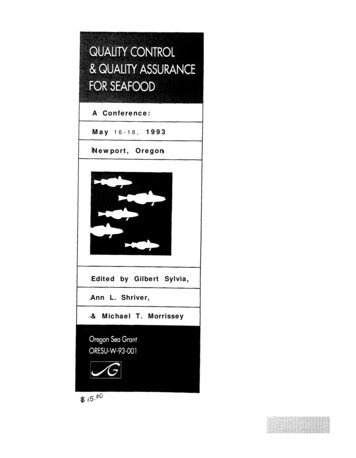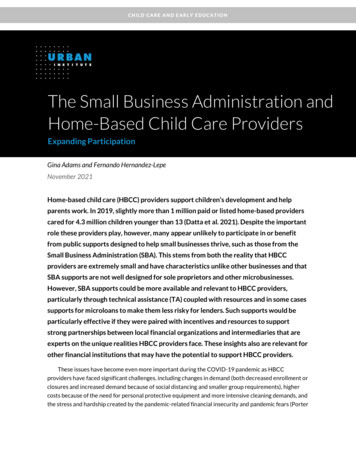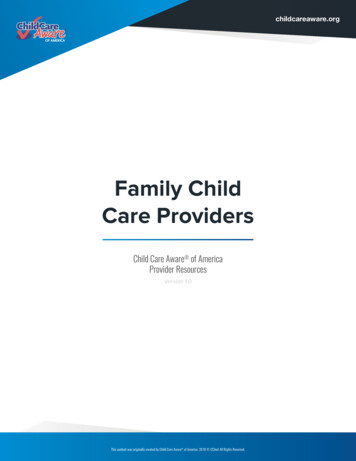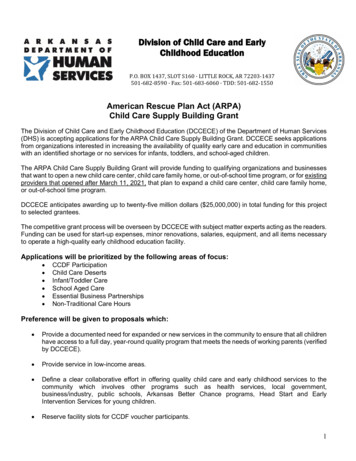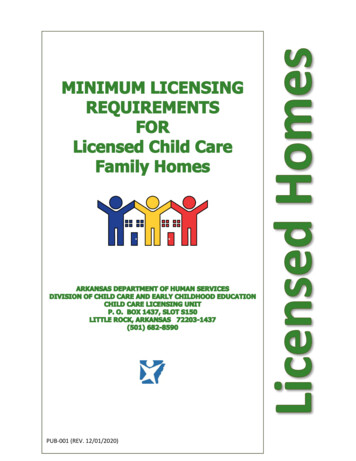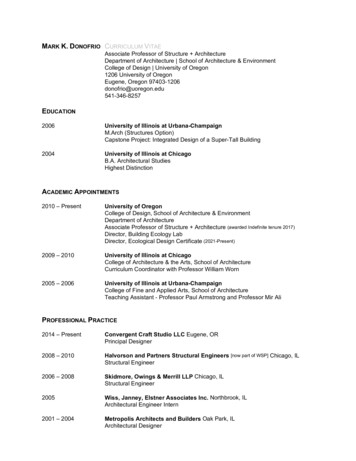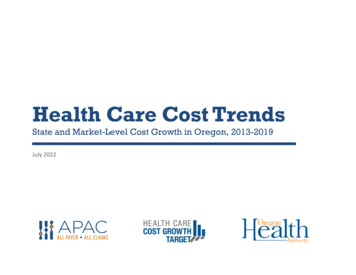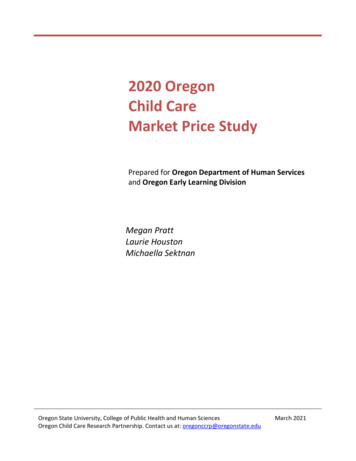
Transcription
2020 OregonChild CareMarket Price StudyPrepared for Oregon Department of Human Servicesand Oregon Early Learning DivisionMegan PrattLaurie HoustonMichaella SektnanOregon State University, College of Public Health and Human SciencesOregon Child Care Research Partnership. Contact us at: oregonccrp@oregonstate.edu2020 Oregon Child Care Market Price StudyMarch 20211
AcknowledgmentsThe 2020 Child Care Market Price Study is built upon the methods, analysis, and writing of Deana Grobeand Bobbie Weber, who have conducted and written fourteen Oregon’s Market Price Studies since the1990s. Much of their writing is included in this report and we appreciate their guidance and supportthroughout the process.This report has benefited greatly from the guidance and commitment of the steering committee,comprised of Anneliese Sheahan, Oregon AFSCME; Michelle Salinas, Salem Child Development Center;David Mandell, Crys O’Grady, Jenny Mendoza, Early Learning Division; Regan Gray, Family Forward;Jennifer Heras, Kirsten Holman, JoAnn Lindorfer, and Joe Litke, Oregon Department of Human Services;Bobbie Weber, Oregon State University; Rachel Hansen, Aaron Giesa, Oregon SEIU; and Cheri Freedman,Western Oregon University. We gratefully acknowledge the members of this committee.Finally, we are grateful to the local CCR&Rs and Central Coordination team for the quality of their workin collecting price and capacity data.2020 Oregon Child Care Market Price Study2
ContentsExecutive Summary . 4Introduction. 11Data . 13DATA SELECTION. 13DATA VALIDITY . 14Methodological Issues . 17WHAT IS INCLUDED IN THE DATA ANALYSIS . 17PRICE PER CHILD CARE SLOTS . 19GEOGRAPHICALLY DEFINED CLUSTERS . 20Findings . 24YEAR 2020 STATEWIDE CHILD CARE PRICES . 24YEAR 2020 GEOGRAPHIC PRICE CLUSTERS . 25COMPARISON OF 2020 MARKET PRICE DATA WITH PREVIOUS MARKET PRICE DATA . 35Conclusions. 39References . 40Appendix A . 43Glossary . 43Appendix B . 44Table B1. 2020 Statewide Prices for Small Home‐based Care. 44Table B2. 2020 Statewide Prices for Certified Center Care . 45Table B3. 2020 Statewide Prices for Large Home‐based Care. 46Appendix C . 47Table C1. 2020 Prices by 2020 Clusters for Small Home‐based Care Slots . 47Table C2. 2020 Prices by 2020 Clusters for Center Care Slots . 48Table C3. 2020 Prices and 2020 Clusters for Large Home‐based Care Slots . 49Appendix D . 50Table D1. 2020 Median Prices for Toddler Care, by County. 50Table D2. 2020 Median County Prices for Toddler, by Facility Type and Pricing Mode . 51Appendix E . 53Table E1. 2020 Clusters by Zip Code, by County. 532020 Oregon Child Care Market Price Study3
Executive Summary2020 Oregon Child Care Market Price StudyEXECUTIVE SUMMARYStarting with the Family Support Act of 1988, “federal funding requirements have stipulated that childcare subsidy rates be informed by market rates.” In 1990 the federal government began a majorinvestment in child care with the passage of the Child Care and Development Block Grant Act (CCDGB).Support of parental choice was a key component of this block grant program that sent new money tostates to support child care. Parental choice and state control of policy remained central when theprogram was expanded in 1996 as a part of welfare reform legislation. At that time, child care fundingbecame known as the Child Care and Development Fund (CCDF). The 2014 Reauthorization of CCDBG Actbroadened the purpose of market rate studies to include concerns that providers have sufficient fundingto provide quality care and introducing issues of cost of providing such care. The goal of parental accessto affordable child care continue, and issues related to the cost of providing quality are added.This Act requires states to conduct a child care market rate survey within two years of the effective dateof their currently approved CCDF plan. Although these surveys are described as market rate surveys bythe federal government, we use the term market price survey because the title clearly distinguishes theprocess of collecting price data from setting maximum payment rates which is done by the state.The purpose of federal policy in having states conduct a market price survey is to have states establishmaximum child care payment rates high enough to enable subsidy families to enter the child caremarket in a competitive position to find and afford care. Another goal is to enable providers to providehigh quality care. A market price survey is a tool to be used by states to collect up‐to‐date informationon what facilities, within given geographic areas, charge parents for various types of child care. Thisinformation is then considered during the state budget process when establishing state subsidy ratepolicies for facilities who serve CCDF eligible families. Up until the 2014 Act, states were directed tostudy prices rather than costs. The costs of child care are the facilities costs to provide care that is oftengreater than the price charged to parents. States are now free to explore ways to study costs. Oregonhas started work in this area that will complement the market price study efforts in the future.Purpose of the2020 OregonMarket PriceStudyThe 2020 Oregon Market Price Study identifies child care prices and thegeographic distribution of these prices across the state. Prices vary by severalfactors including the age of the child served, type of care, the local supply anddemand for child care, and facilities’ perceptions of the capacity of families topay for care. The 2020 Oregon Market Price Study examines geographic patternsin the prices charged by facilities by age of child served, type of care, and pricingmodes (hourly, monthly, daily, weekly). This study fulfills the federalrequirement that the state complete a market price survey no earlier than twoyears before the submission of their CCDF Plan.Data SourcePrior studies were completed in 1990, 1992, 1994, 1999, 2000, 2002, 2004, 2006,2008, 2010, 2012, 2014, 2016, and 2018. As in past years, data collected throughthe local Child Care Resource and Referral (CCR&R) were used as the datasource. The data were created when local CCR&Rs collected price data from childcare facilities for the price study. In 2020 (as in years other than 1999), the pricedata from the NACCRRAware database were analyzed. Prices charged by 3,261facilities from every part of the state were included in the database.2020 Oregon Child Care Market Price Study4
Executive SummaryFindingsBetween 2000 and 2020 statewide prices increased for all ages and types of care.Trends in small home‐based child care prices are graphed below. Also graphed are thesame trends in prices after adjusting for inflation using the consumer price index for allurban consumers (second graph for each type of care). In nominal terms, the hourly ratesfor small home‐based child care has increased since 2000, but after adjusting for inflation,small home‐based child care prices have remained relatively constant for infant andtoddlers, with no increase in infant rates, a small 4% increase in toddler rates, and a 16%increase in preschool age rates. Between 2018 and 2020 small home‐based pricesincreased about 12% (8% inflation adjusted). As in past years, there is little differentiationin prices by age like there is in other types of care.Trends in Small Home‐based Child Care Prices (75th percentile) 4.50InfantToddlerPreschool AgePrice per hour 4.00 3.50 3.00 2.50 2.00 1.502000 2002 2004 2006 2008 2010 2012 2014 2016 2018 2020YearTrends in Small Home‐based Child CareInflation Adjusted Prices (75th percentile, 2019 dollars) 4.50Price per hour 4.00 3.50 3.00Infant 2.50Toddler 2.00Preschool Age arSources: Market Price Studies 2000, 2002, 2004, 2006, 2008, 2010, 2012, 2014, 2016, 2018, 2020Notes: See Table 9 of the full report for prices found in the graphs. Small home‐based providers are almostevenly split between charging hourly and monthly prices in 2020, but have historically charged hourly prices.2020 Oregon Child Care Market Price Study5
Executive SummaryFindings(continued)For center care, prices have steadily increased; in both nominal and real (inflationadjusted) terms. Prices increased faster between 2000 and 2004, leveled off for a fewyears, and then increased again. The percent increase in rates since 2000 (after adjustingfor inflation) has been more than 60% for each of the age groups. Between 2018 and 2020center prices increased about 13% (10% inflation adjusted).Trends in Center Child Care Prices(75th percentile)Price per month 1,800 1,600Infant 1,400Toddler 1,200Preschool Age 1,000 800 600 400 rTrends in Center CareInflation Adjusted Prices (75th percentile) 1,800InfantPrice per Month 1,600Toddler 1,400Preschool Age 1,200 1,000 800 600 400 rSources: Market Price Studies 2000, 2002, 2004, 2006, 2008, 2010, 2012, 2014, 2016, 2018, 2020Notes: See Table 9 of the full report for prices found in the graphs. The majority of centers charge by the month.2020 Oregon Child Care Market Price Study6
Executive SummaryFindings(continued)Large home‐based care prices have been separated from those of small home‐based childcare since 2000. After adjusting for inflation, prices were not keeping up with inflationfrom 2000 through 2008. Since then, prices have more than kept up with inflation for alllarge groups. Since 2000, rates have increased by 33%, 28%, and 32% for infant, toddler,and preschool age groups. Between 2018 and 2020 large home‐based care pricesincreased about 11% (8% inflation adjusted).Trends in Large Home‐based Child Care Prices (75th percentile)Price per month 1,400InfantToddler 1,200Preschool Age 1,000 800 600 rTrends in Large Home CareInflation Adjusted Prices (75th percentile) 1,400InfantToddlerPrice per month 1,200Preschool Age 1,000 800 600 rSources: Market Price Studies 2000, 2002, 2004, 2006, 2008, 2010, 2012, 2014, 2016, 2018, 2020Notes: See Table 9 of the full report for prices found in the graphs. The majority of large home‐basedproviders charge by the month.2020 Oregon Child Care Market Price Study7
Executive SummaryFindings(continued)Child care markets are local with variation among communities. When priceswere analyzed by zip codes across Oregon, patterns around the stateappeared. Urban areas and communities with large universities have higherprices than more rural communities in the state. The market study validatesthe existence of three different small home‐based care price clusters and fourdifferent center and large home‐based child care markets or price clusters inOregon. Higher cluster numbers represent zip codes with higher prices andvice versa for lower cluster numbers. The clusters were determined by using astatistical method that looks for groups or clusters that occur in the price dataand systematically finds the natural breaks between groups. The maps of 2020clusters graphically depict how the prices vary across the state (SeeGeographic Clusters of Child Care Price Maps at the end of this section). Theseclusters by type of care capture distinct sets of prices regardless of age of childserved. The 2020 cluster solution is similar to past studies. Notable changesfrom 2018 include movement to a higher‐price cluster among Portland metroareas zip codes, Bend area zip codes, and zip codes outside of Eugene.ConclusionsChild care prices vary across the state, with three types of markets for smallhome‐based care (relatively low, middle, and high priced zip codes) and fourtypes of markets for centers and large home‐based care. Generally, urbanareas have higher prices than more rural areas.CCR&R data continues to provide a reliable and cost‐effective source of datafor statewide market price studies.Prices should continue to be reported for both child care facilities and slots.Analysis should be based on slots since this most accurately represents whatfamilies experience when purchasing care.Analysis of the predominant mode (hourly, daily, weekly, monthly) used byfacilities to charge parents identified monthly as the most common mode forcenter and large home‐based care. The most common mode for small homebased care was almost evenly split between monthly and hourly, where as inprevious years it was mostly hourly.This study provides a picture of where provider pricing was at in early 2020,right before the state’s first Stay Home, Save Lives Order in March of 2020i.iIn response to COVID‐19 global pandemic, Governor Kate Brown declared a State of Emergency in Oregon on March 8, 2020.On March 25, 2020, child care providers were ordered to close unless they were providing Emergency Child Care (ECC). TheCOVID pandemic and resulting closures have greatly changed the landscape of the child care supply in Oregon. This reportdescribes the price of child care prior to March 1, 2020 (pre‐COVID).2020 Oregon Child Care Market Price Study8
Executive SummaryWhite areas on the map are those without a zip code.2020 Oregon Child Care Market Price Study9
Executive SummaryWhite areas on the map are those without a zip code.2020 Oregon Child Care Market Price Study10
IntroductionINTRODUCTIONStarting with the Family Support Act of 1988, federal funding requirements have stipulated that childcare subsidy rates be informed by market rates.ii In 1990 the federal government began a majorinvestment in child care with the passage of the Child Care and Development Block Grant Act of 1990(42 U.S.C. 9858 et seq; CCDGB). Support of parental choice was a key component of this block grantprogram that sent new money to states to support child care. Parental choice and state control of policyremained central when the program was expanded in 1996 as a part of welfare reform legislation. Atthat time, child care funding became known as the Child Care and Development Fund (CCDF). CCDFoperates as a block grant to States, Tribes, and Territories. Working within federal rules, states controlthe major policy levers for CCDF, whose funding involves a mix of federal and state dollars. The 2014Reauthorization of CCDBG Act broadened the purpose of market rate studies to include concerns thatproviders have sufficient funding to provide quality care. It also introduced attention to issues of coststo provide such care. The goal of parental access continues and issues related to the cost of providingquality are added.As part of this Act, states are required to conduct a child care market rate survey no earlier than twoyears before the submission of their CCDF Plan. Although these surveys are described as market ratesurveys by the federal government, we use the term market price survey because the title clearlydistinguishes the process of collecting price data from setting maximum payment rates, which is done bythe state.The purpose of State payment rate policy is to establish maximum child care payment rates high enoughto enable subsidy families to enter the child care market to find and afford care. A market price survey isa tool used by states to collect up‐to‐date information on what facilities, within given geographic areas,charge parents for various types of child care. This information is then considered during the statebudget process when establishing state subsidy rate policies for providers who serve CCDF eligiblefamilies. Up until the 2014 Act, states were directed to study prices rather than costs. The costs of childcare are the facilities costs to provide care that is often greater than the price charged to parents. Statesare now free to explore ways to study costs. Oregon has started work in this area that will complementthe market price study efforts in the future.In Oregon, the Early Learning Division as the lead agency for CCDF partners with the Department ofHuman Services (ODHS) who administers the subsidy program to oversee the market price survey andrecommends a budget for establishing subsidy policies. As authorized by the 2007 Oregon Legislature,ODHS implemented a significant policy change by increasing maximum subsidy rates to the 75thpercentile of 2006 prices for most licensed facilities and authorized a copay reduction of 24% forparents. This policy change went into effect in October of 2007. Effective October 2013, ODHS increasedmaximum subsidy rates to the 75th percentile of the 2012 Child Care Market Price Study for registeredand certified family child care providers. In addition, the infant age was redefined to better align withthe Early Learning Division’s licensing requirements. Previously the cutoff between infant and toddlercare categories for licensed care was set at 18 months. The new cutoff is set at 24 months for alllicensed providers. In March of 2016, the maximum subsidy rates for all licensed providers wereincreased up to or beyond the 2014 Market Price Study. More recently, increases in maximum subsidyiiThroughout this report, the term market prices or price is used to describe prices that are set in the open market by child carefacilities. This is distinguished from the rate of payment or maximum reimbursement rate established by Oregon Department ofHuman Services for reimbursing child care facilities participating in the subsidy program.2020 Oregon Child Care Market Price Study11
Introductionrates for exempt providers were implemented in October 2017, and small and large home‐basedproviders received an increase in subsidy rates as of January 2018. Rates for all providers were againincreased in January 2019.Past Oregon Market Price Studies have been conducted in 1990, 1992, 1994, 1999, 2000, 2002, 2004,2006, 2008, 2010, 2012, 2014, 2016 and 2018 furthering our knowledge of how the child care marketoperates.iii The objectives of the year 2020 market price study were to: (a) identify current pricescharged for child care (i.e., current market prices), and (b) identify the geographic distribution of currentchild care market prices across the state. A steering committee was formed to oversee and review thefindings of the study. This report further details the data and methodology, reports on the 2020 marketprice analysis, and identifies geographic price areas.iiiSee Ref. 1‐13 for past studies or visit search/child‐care‐prices2020 Oregon Child Care Market Price Study12
DataDATADATA SELECTIONStudy PopulationThe population of interest is the priced child care market in Oregon. Facilities within the priced childcare market have two characteristics:(1) they charge parents a price,(2) the price is established through an arm’s length transaction.In an arm’s length transaction, the buyer and seller do not have a prior relationship or sharedmembership that is likely to affect the price charged.iv The priced market does not include facilities wholimit their care to persons they know, as is commonly the case with family, friend, and neighborcaregivers.Three major types of child care are included in the market price study: small home‐based care, largehome‐based care, and centers.v Small home‐based facilities offer care to a small group of children in thecaregiver’s own home. Large home‐based facilities provide care to a larger group of children, typically ina family home. In Oregon, large‐based facilities must be certified under Oregon State Law and arerequired to meet certain standards not required of a registered family child care facility. Child carecenters operate in a non‐residential facility and must be certified by the Office of Child Care, EarlyLearning Division unless they meet exemption criteria.Data SourceThe study universe includes all child care facilities in the priced child care market. The majority of family,friend, and neighbor caregivers have a prior relationship with the parent; thus, if they do charge a priceit is not established at arm’s length. The price is likely to be influenced by the prior relationship. The vastmajority of family, friends, and neighbors are not part of the priced child care market.The CCR&R database remains the most comprehensive and reliable data source for market prices. Thestatewide CCR&R database of child care facilities is an aggregate of data from 15 local CCR&R agenciesrepresenting all counties in Oregon. CCR&R services in Oregon are provided by 15 independent, localagencies designated by the state. Each CCR&R is contracted to provide services in one of 15 ServiceDelivery Areas (SDA). Most agencies are housed within a larger parent agency, such as a communityaction program or a community college. All Oregon CCR&Rs are members of Central Coordination of theOregon Child Care Resource & Referral, which coordinates and supports them in their efforts.Given that almost all centers and small and large home‐based care are captured in the Child CareResource and Referral (CCR&R) database, the decision was made to use it for the 2020 market pricestudy. The Office of Child Care, Early Learning Division's child care licensing database was not consideredivGrobe, et al.: 2008 (ref. 15).Home‐based child care providers are typically identified by their regulatory status: a) small home‐based providers are knownas registered family child care, and b) large home‐based providers are known as certified family child care. We use the termssmall and large home‐based care rather than the regulatory titles throughout this report.v2020 Oregon Child Care Market Price Study13
Databecause it is not designed to capture facility price data, although it was merged with the CCR&Rdatabase prior to data collection to ensure that all facilities were included. ODHS’s provider databasecontains data on facilities that serve families who receive ODHS child care subsidies. Some of theseproviders are enrolled with a CCR&R and/or regulated by the Office of Child Care. Many ODHS listedproviders, however, provide care only for family members or friends who receive ODHS subsidies forchild care. These facilities probably would not otherwise provide care or do not meet the arm’s lengthcriteria, and thus, are not part of the priced child care market.In contrast, most facilities in the CCR&R database offer care in the priced child care market. The CCR&Rdatabase was used in the 1992, 1994, 2000, 2002, 2004, 2006, 2008, 2010, 2012, 2014, 2016, and 2018Oregon market price studies and has proven to be a reasonable source of price data in mostcommunities.vi The sample of facilities contacted for the 1999 telephone survey was also drawn fromthe CCR&R database. CCR&R data include facility reports of their actual charges; thus, it can be assumedthat these data accurately reflect prices for child care. Finally, in preparation for the download of datafor the price survey, with support from Central Coordination, the local CCR&Rs email and call facilities toassure information on prices and other facility characteristics is current.Each CCR&R uses a software program called NACCRRAware. This database allows CCR&R staff to collectand store information on facilities and parents, and to match up parents seeking child care withcomplementary child care facilities. All facilities that are enrolled with a CCR&R are entered into thedatabase. In addition, Central Coordination conducts monthly merges of CCR&R and Licensing databasesto ensure completeness of the CCR&R database. Information collected about facilities includes: Basic data such as name, address, telephone number.Type of care, days and hours of care, numbers and ages of children served, license and/orregistration statusCare charges (prices) for ages served.These data elements are entered into the database. There is a major update of the database each yearand minor updates each quarter. In addition, the database is updated whenever a facility notifies theCCR&Rs of changes in prices or other information.For the market price survey, the CCR&Rs contact all facilities within a three‐month period to collectcurrent price and capacity data. Central Coordination checks the data for accuracy, then provides onelarge database, from which various statistical reports can be drawn. Each year, Oregon finds additionaluses for this centralized database. Currently, this database provides data for various research needsincluding the ODHS Market Price Survey, the child care benchmarks, and the Oregon Child Care ResearchPartnership Estimating Supply study.CCR&R 2020 Database CharacteristicsIn 2020, Central Coordination managed a data update process in which data on capacity and price byage group were collected from all active Oregon child care facilities within a four‐month period (January‐April) to ensure all data were comparable and current. Of relevance for these analyses, the datasetincluded data on each facility’s regulatory status, capacity, and price by age group as of March 1, 2020(pre‐COVID).viReferences 2 through 13.2020 Oregon Child Care Market Price Study14
DataThese data contained 5,322 facility records; 2,129 (40%) were small home‐based child care facilities,2,297 (43%) centers, and 896 (17%) large home‐based care. After facility records without price data andthose that were not considered part of the child care market were eliminated, the sample was 3,261facilities including 1,650 small home‐based care, 819 centers, and 792 large home‐based care. Half offacilities (51%) were small home‐based child care facilities, 2,187 (25%) centers, and 890 (24%) largehome‐based care. (See Methodological Issues for discussion of data that were and were not included inthe market price study data analysis).DATA VALIDITYData are valid if they measure what they are intended to measure.vii Basic to the validity of market pricestudy findings is the extent to which the facilities from which price data are collected represent allfacilities with child care prices. Factors that affect the representativeness of market price study findingsinclude: completeness of data, geographic representativeness, response rate, and currency of the data.On each of these indicators, the CCR&R 2020 database was assessed to be valid. Data Completeness. Data were very complete with limited missing data for critical variables forfacilities that met the definition of a priced child care market. For example, of the total sample offacilities (4571), approximately 29% had no full time price data. This 29% included facilities (suchas Head-Start programs) who do not directly charge consumers and thus have no prices to report.Other facilities do not submit prices for a variety of reasons. Reasons for missing price datainclude complicated, variable pricing structures, or preferring to discuss prices directly withparents. Overall, the price data were complete for 71% of the facilities in the CCR&R databasethat are a part of the priced market, and 90% of these values met the price currency standard an
Findings Between 2000 and 2020 statewide prices increased for all ages and types of care. Trends in small home‐based child care prices are graphed below. Also graphed are the same trends in prices after adjusting for inflation using the consumer price index for all
